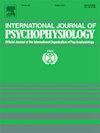Differences in resting-state theta power predicts vulnerability in alertness during prolonged wakefulness
IF 2.5
3区 心理学
Q3 NEUROSCIENCES
引用次数: 0
Abstract
Prolonged wakefulness—such as staying up for work or study—is a common form of sleep loss in modern society. Previous research using sleep-deprivation paradigms has indicated inter-individual differences in vulnerability to sleep loss, but the neural correlates of such vulnerability during prolonged wakefulness remain unclear. In a laboratory-controlled setting, we examined individual differences in alertness alteration during overnight wakefulness—a more common form of sleep loss in real life—and explored the associated resting-state EEG spectral signatures. Forty-five participants remained awake from 22:00 to 06:00, during which they completed subjective ratings, a 10-min psychomotor vigilance task (PVT), and resting-state EEG recordings every 2 h. Based on the changes in overnight PVT performance, participants were grouped as vulnerable (N = 20) or resilient (N = 20). Vulnerable individuals exhibited larger variations in frontal theta power, whereas resilient individuals demonstrated relatively stable resting-state EEG activities during prolonged wakefulness. Furthermore, higher theta power in the parietal region was observed in vulnerable people before prolonged wakefulness, which might be a predictor of vulnerability to prolonged wakefulness. Future studies with larger and independent datasets are needed to validate these spectral indicators and clarify underlying mechanisms.
静息状态θ波能量的差异预示着长时间清醒时警觉性的脆弱性
长时间不清醒——比如熬夜工作或学习——是现代社会中一种常见的睡眠缺失形式。先前使用睡眠剥夺范式的研究表明,个体对睡眠缺失的易感性存在差异,但长时间清醒时这种易感性的神经相关性尚不清楚。在实验室控制的环境中,我们检查了夜间清醒时警觉性改变的个体差异——这是现实生活中更常见的睡眠缺失形式——并探索了相关的静息状态脑电图频谱特征。45名参与者在22:00至06:00期间保持清醒,在此期间,他们完成主观评分、10分钟的精神运动警戒任务(PVT)和每2小时静息状态EEG记录。根据夜间PVT表现的变化,参与者被分为易感组(N = 20)和弹性组(N = 20)。脆弱个体的额波功率变化较大,而弹性个体在长时间清醒状态下的静息状态脑电图活动相对稳定。此外,易受伤害的人在长时间清醒前观察到的顶叶区域的θ波功率更高,这可能是对长时间清醒的易感性的预测。未来的研究需要更大的和独立的数据集来验证这些光谱指标和阐明潜在的机制。
本文章由计算机程序翻译,如有差异,请以英文原文为准。
求助全文
约1分钟内获得全文
求助全文
来源期刊
CiteScore
5.40
自引率
10.00%
发文量
177
审稿时长
3-8 weeks
期刊介绍:
The International Journal of Psychophysiology is the official journal of the International Organization of Psychophysiology, and provides a respected forum for the publication of high quality original contributions on all aspects of psychophysiology. The journal is interdisciplinary and aims to integrate the neurosciences and behavioral sciences. Empirical, theoretical, and review articles are encouraged in the following areas:
• Cerebral psychophysiology: including functional brain mapping and neuroimaging with Event-Related Potentials (ERPs), Positron Emission Tomography (PET), Functional Magnetic Resonance Imaging (fMRI) and Electroencephalographic studies.
• Autonomic functions: including bilateral electrodermal activity, pupillometry and blood volume changes.
• Cardiovascular Psychophysiology:including studies of blood pressure, cardiac functioning and respiration.
• Somatic psychophysiology: including muscle activity, eye movements and eye blinks.

 求助内容:
求助内容: 应助结果提醒方式:
应助结果提醒方式:


